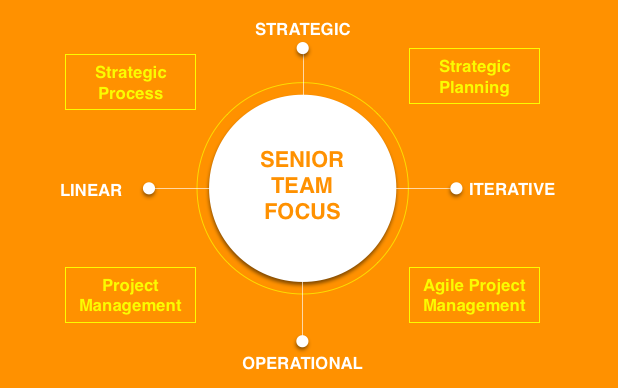Welcome back to the Meeting Expectations mini-series. If you haven’t yet read Part 1, 2, or the full ‘Meeting Expectations’ article then don’t worry, you’ll still be able to follow along, but meetings are so often an issue of contention that it’s worth getting as much information as you can on how to improve them!
I’m sure you’re familiar with the stereotype of meetings as boring, unproductive and so cripplingly dull they make you never want to look at a pie chart again. If you have never experienced this, you’re one of the lucky few.
Meeting do not have to be a waste of time, however. They can be valuable, interesting and productive. All that’s needed is the correct focus.
In this article, we’ll discuss the usefulness of understanding your ‘core approach’ and, for that matter, what a core approach actually is.
The Four Types of Focus
Have a look at the diagram above – it shows the four types of core approach that senior teams usually stick to. You can be strategic or operational (but not both at once) and you can be linear or iterative. You ca refine your process through repeated cycles or exploration, or you can work in a structured way step-by-step.
Of course, each area has its own strengths and weaknesses, and is suited to different circumstances. But, as obvious as it may seem, many people do not realise this. A lack of understanding over core focus is a constant source of headaches during meetings.

Those who are, for example, Operational-Linear may see those who are Strategic-Iterative as ‘fluffy’ time wasters with their heads in the clouds and no concern for the real world. Those who are Strategic-Iterative may see those who are Operational-Linear as curmudgeonly ‘luddites’, stuck in their ways. Neither sideis really correct of course, they are simply different ways of doing things.
A Thought Experiment
Have a look at the diagram and identify where you spend the most time. Do you concentrate most on strategic decisions, or operational ones? Do you prefer your work structured, or more open?
Now think about the person on your team with whom you fall out the most often, or have difficulty working with. Chances are, they work in a different (if not entirely opposite) quadrant than you do. This is likely to be a key component of your difficulty with them.
Focus in Action

So, where do your team need to be in order to deliver a successful business plan? The answer is: ‘everywhere!’ The delivery of any business plan almost certainly requires work in all four quadrants of team focus.
Learning to work these four areas together in meetings is one of the secrets of effective meeting process. An ideal illustration would be to style your business process in such a way as to go through all four quadrants cyclically (in fact I have seen this done with a client – they doubled their revenues in a year!). This makes your business robust and utilised the skills, preferences and abilities of everyone in a meeting.
Working in all four quadrants can be a complicated process, but it really is necessary for top-level performance. Bear it in mind during your next meeting and see what changes you can make. I promise it will be worth it.

